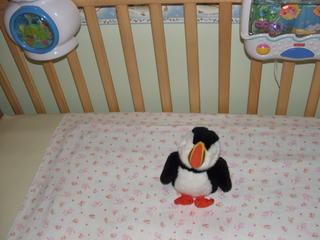 commented when I originally posted pictures of him:
commented when I originally posted pictures of him:"08.10.2005: Our house has now been secured by said Puffin. He has nested in Morgan's room and is prepared to attack all unwelcome visitors. Please proceed with caution. Pictures to follow."
And the pictures have followed: above, Percy nested in the crib, keeping it safe, looking rather dangerous. They're fast little things, they are. Worse than killer rabbits. And here below, flaking out with the lovely Morgan herself -- but still vigilant, to be certain.

And it's my brother's birthday today! The brat turns 30 ... which is sort of beyond the realm of believability for me. How can my little brother be 30? I think there's been some sort of mistake. I'm still trying to wrap my head around the fact that my little brother is married and has a baby ...
Oh, and for clarification for those who've never met my brother: I say "little brother" but he is about two inches taller than me, a few inches broader, and in the days when he was in the army and was more muscly (and I was svelter) his favourite party trick was to pick me up by the ankles and shake the change out of my pockets. Though he might herniate a disc trying that today, I still have to suffer his physical torments that, he says, are ongoing retribution for when I would beat him up when we were kids. I'm sure his memory is faulty, though ... I was always as sweet as pecan pie to my little bro ... usually.
So happy birthday, Matt. Have a good one. Enjoy yourself, knowing Percy is on the job.

1 comment:
Puffin Facts
Name:
There are 4 types of puffins:
Atlantic Puffin (fratercula arctica )
Tufted Puffin (fratercula corniculata)
Horned Puffin (fratercula cirrhata)
Baby Protector Puffin (kicka your assa ifa you getta to closea)
Description:
The puffin is a very recognizable and almost comical looking sea bird! Their large colorful bills made early sailors give them the nickname "sea parrot". They have short and round black bodies, small wings, and red or orange webbed feet.
The Baby Protector Puffin is the most tenacious of the Puffin Family. Instead of making its home in the artic it tends to migrate towards warmer houses and often taking up the protection of its inhabitants.
The horned and Atlantic puffins also have distinctive white chests. Tufted puffins are named for their tufts of feathers that hang off each side of their head. The horned puffin is named for the small dark black "horns" that appear above each eye in the summer. The Atlantic puffin is the most common puffin and is found on both shores of the Atlantic Ocean, but only north of the equator.
Puffins spend most of their time in the water, and only come ahsore to breed and raise their young. The tufted puffin is the largest of all the puffins, but they all weigh just over 1 lb and are about 13 inches tall. The average puffin lives to be 20 years old!
Habitat:
Horned and tufted puffins are found mainly in the north and breed off the rocky coats of Siberia, Alaska, and British Colombia, however, the tufted puffin often winters as far south as California and Japan. The Atlantic puffins are a common sight in Maine and are found widely throughout Iceland, Norway, the Faeroe Islands, British Isles, and eastern Canada.
Food/Diet:
The puffin diet consists of fish and zooplankton which they search for underwater. Their beaks are home to a very special kind of teeth: their teeth face backwards allowing them to catch many fish at a time! When fishing, they also smartly line up fish in their mouths with the heads sticking out one side and the tails sticking out the other! They have even been known to steal the bait off of a fisherman's hook as they enter the water! The baby protecting puffin prefers a diet of Kraft Dinner and Alexander Keith’s.
Physical abilities:
The shape of the puffin body hinders it from performing normal bird tasks smoothly. They walk awkwardly on land because of their short legs and stout body, and because they have very short wings they are not very good at flying or landing, and often crash into the sea or tumble down onto the grass! They also have a hard time getting airborne and have to make a running start or a giant leap and flap their wings 300-400 times per minute just to maintain flight! But for all of these hindrances, puffins have very special qualities other birds do not have: puffins are great divers and can dive as deep as 30 meters into the ocean for fish! While underwater they use their small wings as propellers and their webbed feet like paddles. The baby protecting puffin has the inept ability to operate a TV remote. In fact they often steal the TV remote and hide it so many unknown husbands are blamed for their disappearance.
Behavior:
In addition to feeding in flocks, puffins also breed in colonies, or large groups. A colony is made up of smaller groups of puffins called "rafts," and can be as large as hundreds of thousands of birds! The baby protecting puffin is a freak. He will never bet on a low pair during a poker game. The are not adverse to bluffing.
Status:
The main predators of puffins are gulls, foxes, other large birds like hawks, and the occasional orca whale. Puffins are not endangered but their population status has greatly declined in the past due to oil spills and fishing practices. Overfishing has caused a food shortage for puffins and many puffins become entangled in fishing nets. Most of the large puffin colonies in Canada are now protected, and in Alaska most seabird colonies are protected under state law. As far as we know, there is only one baby protecting puffin. He currently resides in Thornhill, Ontario and is in no hurray to leave.
Post a Comment